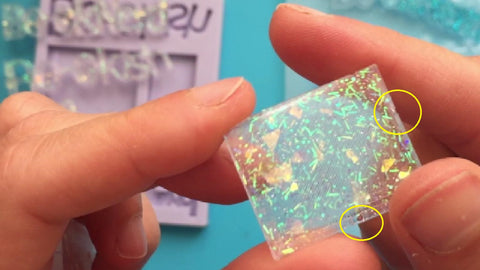Silicone vs. Plastic Molds for Resin Casting: which molds are best for resin?
Share
Plastic resin molds and silicone molds are both suitable for your resin casting projects. What you will ultimately decide to use may depend on your preference, experience or your project needs.
I will go through some of the differences between plastic molds and silicone molds, which will help you decide which molds to buy for your crafting needs.
Difference Number 1: Flexibility
Both plastic and silicone molds are flexible, however, compared to each other silicone molds tend to be much more flexible. As you will see later on in this blog post, this has both it's advantages and disadvantages.


Difference Number 2: Move-ability
Since plastic molds are less flexible and are very stable (compared to silicone molds), they are much safer to move around when they are filled with uncured resin. Especially if you are working with more than 1 layer. This makes them an ideal option for resin beginners.
If it's just one layer of resin (like in the below photo), you can move around silicone molds. You just need to be careful and account that the mold is bendy. Otherwise you can easily spill your resin over.

On the other hand, plastic molds are very stable and you can move them around without any issues or concerns. Just make sure to keep them leveled when moving them to avoid spilling uncured resin.
If you are working with multiple layers of resin, you need to be very careful when using silicone molds, especially (but not only) if you will be moving the mold. You need to keep in mind that when handling and moving, you can risk detaching the cured resin from the mold, and the uncured resin will seep into these areas. Sometimes this might happen at the edges, which might not be such a disaster. However, if this happens to the front, it will require lots of sanding and work to save your creation.
If you are new to resin or new to silicone molds, I would suggest experimenting a bit so that you can learn. Move your silicone molds with cured and also uncured resin to get the feel of it. Experiment with small pieces or with extra resin. That way you won't waste resources.
Difference Number 3: De-molding Technique
When it comes to de-molding your cured resin from your mold, the technique that I use varies depending on whether I am using a silicone mold or a plastic mold.
For silicone molds I just peel the mold and resin away from each other like I show in the photo below.

With silicone molds you need to be gentle. They are very easy to de-mold your resin from, however silicone tends to be more fragile compared to plastic, especially in detailed areas. So I would suggest you take a gentle approach.
Compared to plastic molds, you can de-mold your resin from silicone molds before it is fully cured. This is not ideal, as you might end up ruining your resin piece if you are not too careful, or if you are new, but I know some of you do this, which is obviously not an issue if you know what you're doing.
To de-mold your resin from plastic molds:
- keep your mold facing downwards toward your working space
- grab the mold from the edges and twist the mold gently. Continue doing this from different sides. This will separate the cured resin from the mold and air goes in
- push the resin out of the mold like shown in the photo below

To see a video tutorial on the easiest method to de-mold resin from plastic molds you can watch this YouTube video.
As opposed to silicone molds, I highly suggest waiting for your resin to fully cure before de-molding when it comes to plastic molds. When the resin is fully cured, it's much easier to get your resin out. Otherwise, it will take you longer and much more effort to de-mold resin which is not fully cured. It also helps to take care of your molds and they will last you much longer.
Both plastic molds and silicone molds are very easy to de-mold your resin from. You just need to use the right approach depending on which mold type you are working with.
Difference Number 4: Detail
Due to the varying nature of the methods used to make plastic molds and silicone molds, the level of detail may differ. In some cases, silicone molds tend to be more detailed compared to plastic molds.
For example, in the word molds below, the detail of the silicone mold is much better than the plastic mold. Both work well, however, the mold type you choose will depend on the result / level of detail that you want.


On the other hand when it comes to the book mold, the detail does not vary at all between the silicone mold and plastic mold.

Therefore another thing to consider is the level of detail that your project requires, as well as the level of detail of the particular design/mold.
Difference Number 5: Air Bubbles
The most common problem that occurs when working with silicone molds is the air bubbles that get caught at the front edges. This rarely is a problem when you are working with plastic molds.


Although there are ways to remove these bubbles, it's very easy to miss one of these tiny bubbles when you're removing them (unless you are using a decompressor), and it's one of the downsides to using silicone molds.
Other things to consider
Cost - Plastic molds tend to be more affordable compared to silicone molds. Depending on your project, you might consider buying a plastic mold if it's something that you will only be making once.
Re-usability - Both silicone molds and plastic molds are reusable. They will both last you a very long time if you take care of them.
Scratches - Plastic molds can be easily scratched, whilst you cannot scratch silicone molds. To avoid this, I suggest using silicone tools when possible and avoid using toothpicks or metal tools in your plastic mold.*
Cleaning - Plastic molds are much easier to clean. In most cases there is nothing to clean, or you just pop the spillages away once cured. Silicone molds will require a bit more effort and you will need to clean the mold after each use, and most probably before using as well (depending on where you store the molds). Dust particles and glitter love getting stuck to silicone molds. **
Both plastic molds and silicone molds have their own advantages and limitations. If you are new to resin, I suggest you experiment and work with both. It's good to learn to use both as you will be more flexible to tackle different projects depending on it's needs. By time you will surely develop your preference, which you can only achieve with your experience.
Watch the video here:
Notes:
* If your plastic gets scratched for one reason or another, don't worry. You can still use it. Just dome your resin piece once it's out of the mold or use a nice thick glaze, and the scratches will fill out.
** For an easy way to clean your silicone mold watch this YouTube video.
